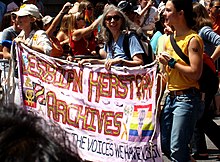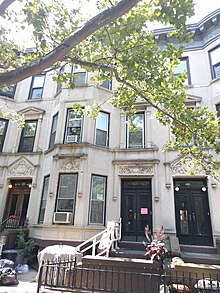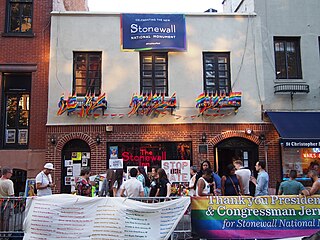
The Stonewall Inn is a gay bar and recreational tavern at 53 Christopher Street in the Greenwich Village neighborhood of Manhattan in New York City. It was the site of the 1969 Stonewall riots, which led to the gay liberation movement and the modern fight for LGBT rights in the United States. When the riots occurred, Stonewall was one of the relatively few gay bars in New York City. The original gay bar occupied two structures at 51–53 Christopher Street, which were built as horse stables in the 1840s.
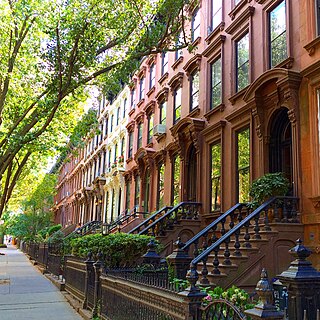
Park Slope is a neighborhood in western Brooklyn, New York City, within the area once known as South Brooklyn. Park Slope is roughly bounded by Prospect Park and Prospect Park West to the east, Fourth Avenue to the west, Flatbush Avenue to the north, and Prospect Expressway to the south. Generally, the neighborhood is divided into three sections from north to south: North Slope, Center Slope, and South Slope. The neighborhood takes its name from its location on the western slope of neighboring Prospect Park. Fifth Avenue and Seventh Avenue are its primary commercial streets, while its east–west side streets are lined with brownstones and apartment buildings.
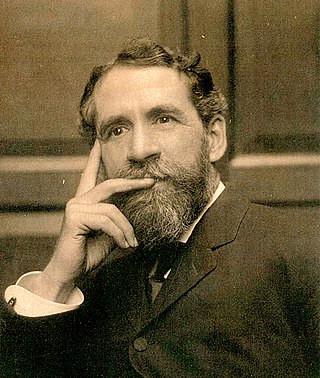
William Bunker Tubby was an American architect who was particularly notable for his work in New York City.

CLAGS: The Center for LGBTQ Studies was founded in 1991 by professor Martin Duberman as the first university-based research center in the United States dedicated to the study of historical, cultural, and political issues of lesbian, gay, bisexual, and transgender (LGBTQ) individuals and communities. Housed at the Graduate Center, CUNY, CLAGS sponsors public programs and conferences, offers fellowships to individual scholars, and functions as a conduit of information. It also serves as a national center for the promotion of scholarship that fosters social change.

The Center for Brooklyn History is a museum, library, and educational center founded in 1863 that preserves and encourages the study of Brooklyn's 400-year history. The center's Romanesque Revival building, located at Pierrepont and Clinton Streets in Brooklyn Heights, was designed by George B. Post and built in 1878–1881 by David H. King Jr., is a National Historic Landmark and part of New York City's Brooklyn Heights Historic District. The CBH houses materials relating to the history of Brooklyn and its people, and hosts exhibitions which draw over 9,000 members a year. In addition to general programming, the CBH serves over 70,000 public school students and teachers annually by providing exhibit tours, educational programs and curricula, and making its professional staff available for instruction and consultation.
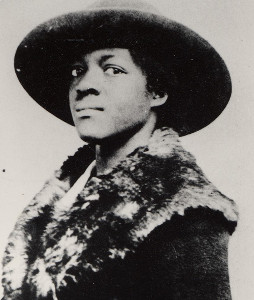
Mabel Hampton was an American lesbian activist, a dancer during the Harlem Renaissance, and a volunteer for both Black and lesbian/gay organizations. She was a significant contributor to the Lesbian Herstory Archives.

Joan Nestle is a Lambda Award winning writer and editor and a founder of the Lesbian Herstory Archives, which holds, among other things, everything she has ever written. She is openly lesbian and sees her work of archiving history as critical to her identity as "a woman, as a lesbian, and as a Jew."
Abraham Edel was a North American philosopher and ethicist. He was the younger brother of the North American literary critic and biographer Leon Edel, and the uncle of the composer Joel Mandelbaum. He was married three times; his first two wives were fellow academics and co-authors, the anthropologist May Mandelbaum Edel, the philosopher Elizabeth Flower, and Sima Szaluta respectively.
Joan E. Biren or JEB is an American feminist photographer and film-maker, who dramatizes the lives of LGBT people in contexts that range from healthcare and hurricane relief to womyn’s music and anti-racism. For portraits, she encourages sitters to act as her “muse”, rather than her “subject”. Biren was a member of The Furies Collective, a short-lived but influential lesbian commune.
The Salsa Soul Sisters, today known as the African Ancestral Lesbians United for Societal Change, is the oldest black lesbian organization in the United States.Operating from 1974 to 1993, the Salsa Soul Sisters identified as lesbians, womanists and women of color, based in New York City Arguments within the Salsa Soul Sisters resulted in the disbanding of the Salsa Soul Sisters into two groups, Las Buenas Amigas made for Latinas, and African Ancestral Lesbians United for Societal Change made for African-diaspora lesbians.
The Gay Academic Union (GAU) was a group of LGBT academics who aimed at making the academia more amenable to the LGBT community in the United States. It was formed in April 1973, just four years after the Stonewall riots, held 4 yearly conferences and conducted other scholarly activities. It disbanded some time after that.
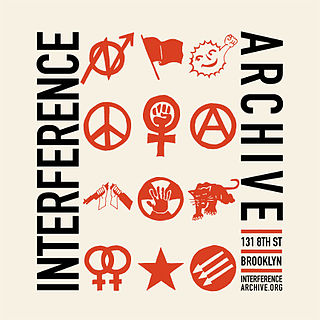
Interference Archive is a volunteer-run library, gallery, and archive of historical materials related to social and political activism and movements. Located in the Park Slope neighborhood of Brooklyn, New York City, at 314 7th Street, with in the zip code 11215, its mission is "to explore the relationship between cultural production and social movements."
The Activist Women's Voices collection is an oral history project of 35 women activists who worked in community-based organizations in the New York City area. The project covers the period from 1995 to 2000 and was a project of The City University of New York (CUNY) Graduate Center's Women's Studies Program and Center for the Study of Women. The digitized collection is made up of women from a diverse cross-section of cultural and ethnic social service organizations including activists from Arab-American, Haitian, Hispanic, African-American, and Asian-American communities. It is held at the Mina Rees Library, within the Graduate Center's B. Altman and Company Building.
The following is a timeline of lesbian, gay, bisexual, transgender and queer (LGBTQ) journalism history.

Maxine Wolfe is an American author, scholar, and activist for AIDS, Civil Rights, lesbian rights, and reproductive rights. Wolfe is a co-founder of the Lesbian Avengers, a coordinator at the Lesbian Herstory Archives, and a member of Queer Nation. Wolfe is currently a Professor Emerita of Women's and Gender Studies at the Graduate Center, CUNY.

Sunset Park is a 24.5-acre (9.9 ha) public park in the neighborhood of Sunset Park, Brooklyn, New York City, between 41st and 44th Streets and 5th and 7th Avenues. The modern-day park contains a playground, recreation center, and pool. The recreation center and pool comprise the Sunset Play Center, which was designated as both an exterior and interior landmark by the New York City Landmarks Preservation Commission. The park is operated by the New York City Department of Parks and Recreation, also known as NYC Parks.
Connexxus Women's Center/Centro de Mujeres was a non-profit community organization established in January 1985 in West Hollywood, California. The organization was co-founded by Adel Martinez and Lauren Jardine in 1984 as a women-run center in Los Angeles, and provided services that catered to women, particularly lesbians and a space in which lesbians could thrive professionally, personally, and socially. In January 1988, it opened an additional facility in East Los Angeles named Connexxus East/Centro de Mujeres made for outreach to the Latina and Chicana communities. The new facility provided services primarily to lesbians in Los Angeles County, and facilitated information about and access to various human service agencies. It also provided counseling in developing and operating small businesses. The facility also sponsored and hosted cultural and educational activities. The 1,400 square-foot center contained space for a library, workshops, rap groups, counseling meetings, and social activities.
Queer community archives are a subset of the larger body of community archives, which are archives and personal collections maintained by community groups who desire to document their cultural heritage based on shared experiences, interests, and/or identities. As such, queer community archives are collections that exist to maintain the historical record of the LGBT community and broader queer community. The term queer community archives, also called gay and lesbian archives, refers to a diverse array of community projects, organizations, and public institutions that maintain these histories.
Deborah Edel is an American activist, archivist, and psychologist. She is best known for co-founding the Lesbian Herstory Archives with Joan Nestle.




